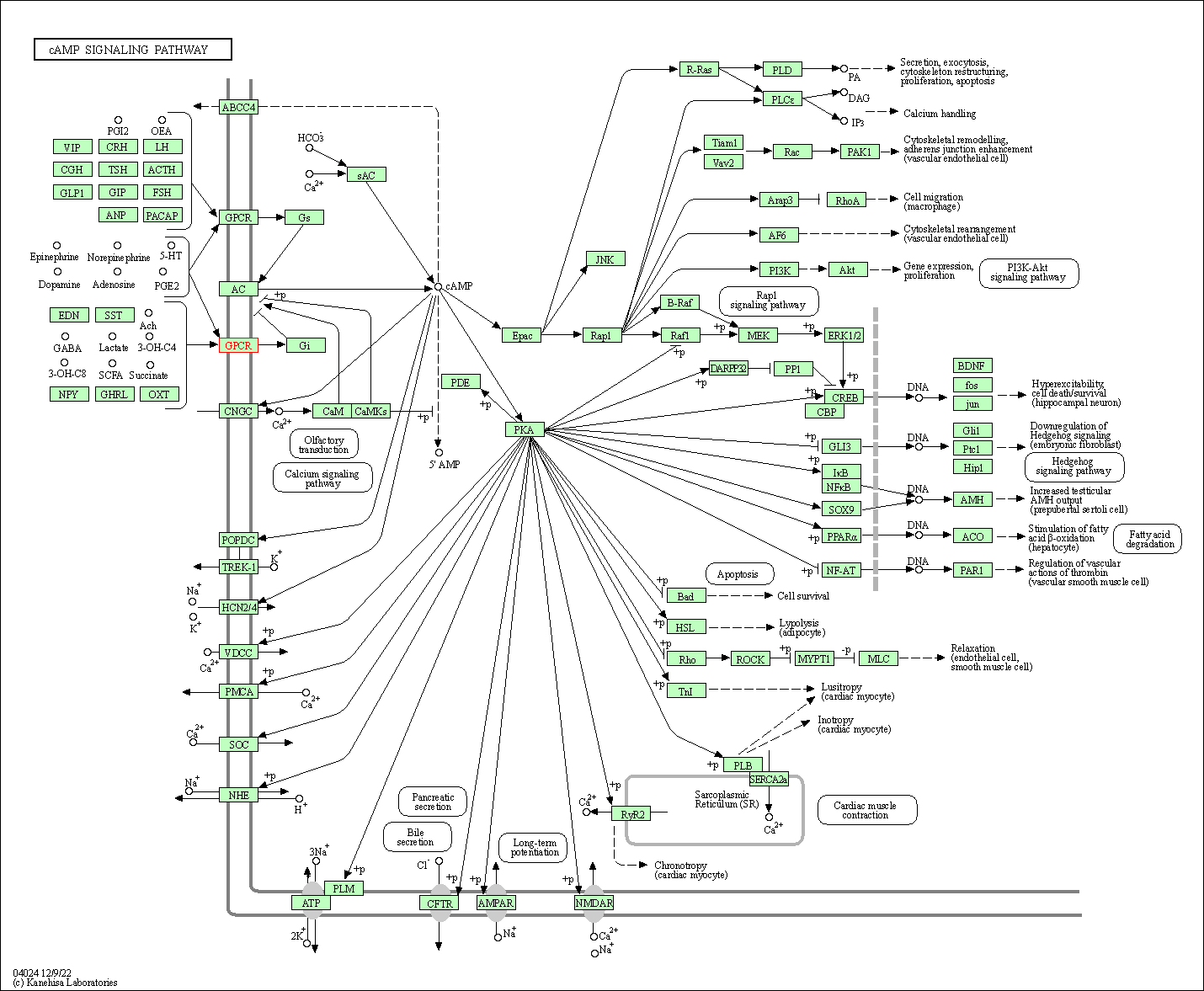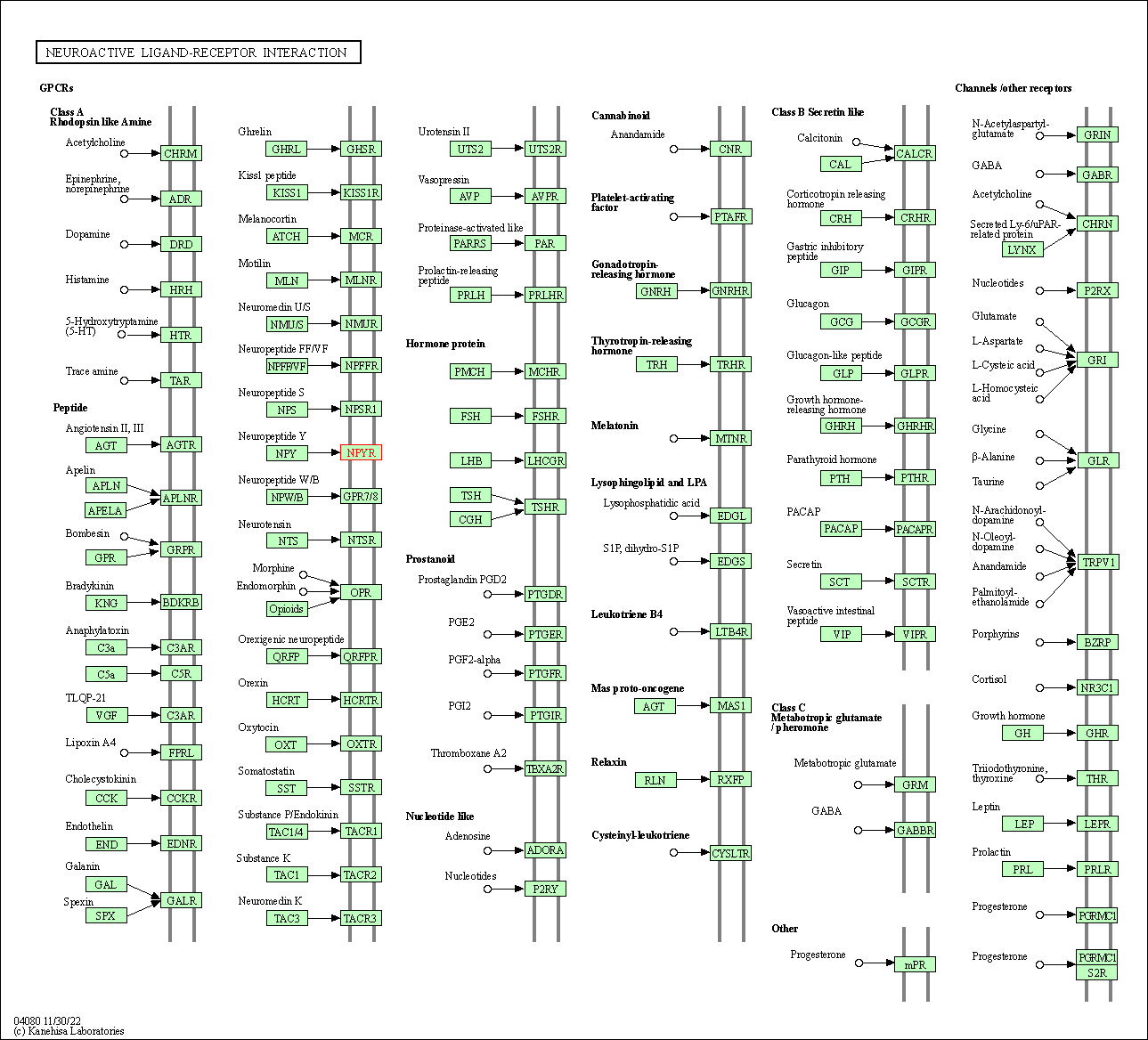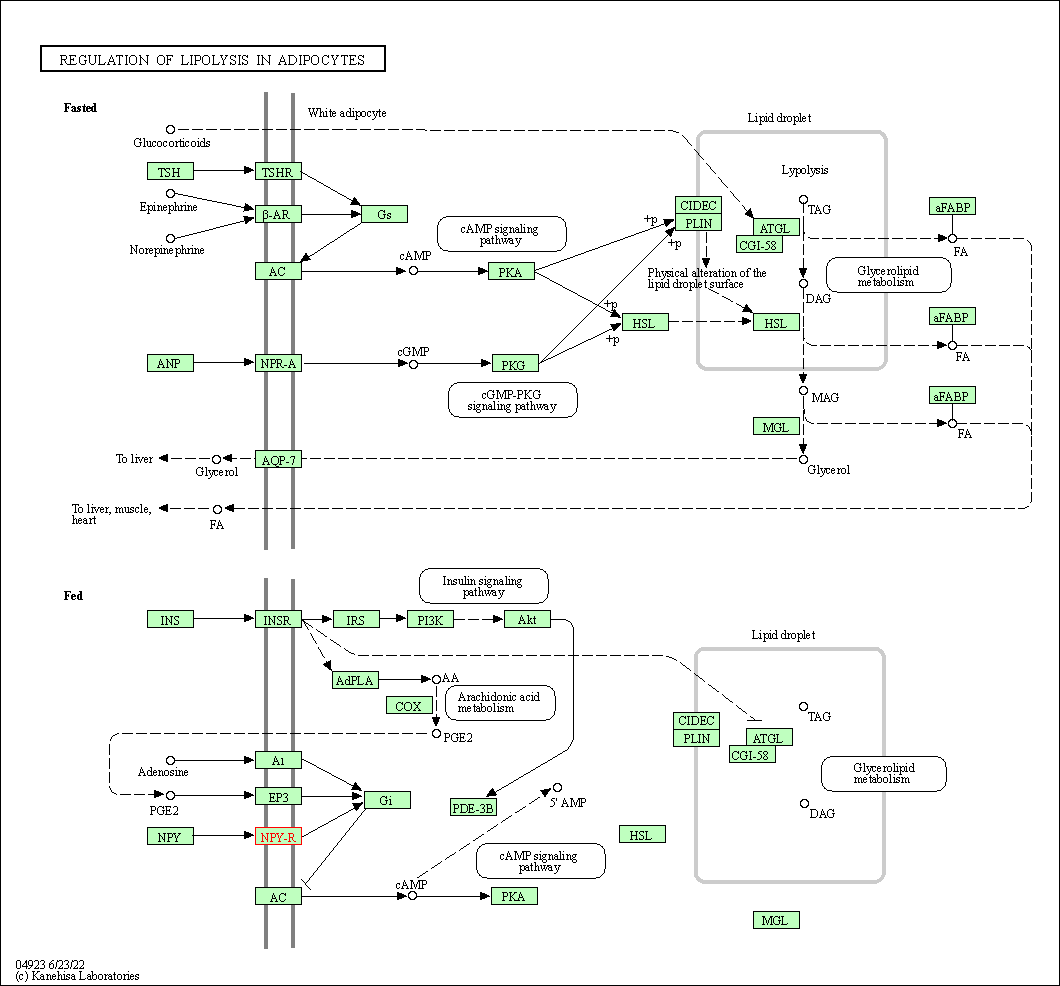Target Information
| Target General Information | Top | |||||
|---|---|---|---|---|---|---|
| Target ID |
T89213
(Former ID: TTDC00193)
|
|||||
| Target Name |
Neuropeptide Y receptor type 1 (NPY1R)
|
|||||
| Synonyms |
Neuropeptide Y-Y1 receptor; Neuropeptide Y receptor Y1; Neuropeptide Y Y(1) receptor; NPY1R; NPY1-R
Click to Show/Hide
|
|||||
| Gene Name |
NPY1R
|
|||||
| Target Type |
Clinical trial target
|
[1] | ||||
| Disease | [+] 5 Target-related Diseases | + | ||||
| 1 | Cardiovascular disease [ICD-11: BA00-BE2Z] | |||||
| 2 | Heart disease [ICD-11: BA41-BA42] | |||||
| 3 | Hypertension [ICD-11: BA00-BA04] | |||||
| 4 | Obesity [ICD-11: 5B80-5B81] | |||||
| 5 | Binge eating disorder [ICD-11: 6B82] | |||||
| Function |
Receptor for neuropeptide Y and peptide YY. The rank order of affinity of this receptor for pancreatic polypeptides is NPY > [Pro-34] PYY, PYY and [Leu-31, Pro-34] NPY > NPY (2-36) > [Ile-31, Gln-34] PP and PYY (3-36) > PP > NPY free acid.
Click to Show/Hide
|
|||||
| BioChemical Class |
GPCR rhodopsin
|
|||||
| UniProt ID | ||||||
| Sequence |
MNSTLFSQVENHSVHSNFSEKNAQLLAFENDDCHLPLAMIFTLALAYGAVIILGVSGNLA
LIIIILKQKEMRNVTNILIVNLSFSDLLVAIMCLPFTFVYTLMDHWVFGEAMCKLNPFVQ CVSITVSIFSLVLIAVERHQLIINPRGWRPNNRHAYVGIAVIWVLAVASSLPFLIYQVMT DEPFQNVTLDAYKDKYVCFDQFPSDSHRLSYTTLLLVLQYFGPLCFIFICYFKIYIRLKR RNNMMDKMRDNKYRSSETKRINIMLLSIVVAFAVCWLPLTIFNTVFDWNHQIIATCNHNL LFLLCHLTAMISTCVNPIFYGFLNKNFQRDLQFFFNFCDFRSRDDDYETIAMSTMHTDVS KTSLKQASPVAFKKINNNDDNEKI Click to Show/Hide
|
|||||
| 3D Structure | Click to Show 3D Structure of This Target | AlphaFold | ||||
| Drugs and Modes of Action | Top | |||||
|---|---|---|---|---|---|---|
| Discontinued Drug(s) | [+] 2 Discontinued Drugs | + | ||||
| 1 | H-409/22 | Drug Info | Discontinued in Phase 2 | Cardiovascular disease | [2] | |
| 2 | SR 120819A | Drug Info | Terminated | Eating disorder | [6], [7] | |
| Preclinical Drug(s) | [+] 2 Preclinical Drugs | + | ||||
| 1 | GI-264879A | Drug Info | Preclinical | Obesity | [3] | |
| 2 | PD-160170 | Drug Info | Preclinical | Heart disease | [3] | |
| Mode of Action | [+] 2 Modes of Action | + | ||||
| Inhibitor | [+] 13 Inhibitor drugs | + | ||||
| 1 | NEUROPEPTIDE-Y | Drug Info | [1], [8] | |||
| 2 | 4-(4-butylpiperidin-1-yl)-1-o-tolylbutan-1-one | Drug Info | [11] | |||
| 3 | AcPYY(22-36) | Drug Info | [12] | |||
| 4 | BMS-189323 | Drug Info | [13] | |||
| 5 | BMS-245782 | Drug Info | [13] | |||
| 6 | H-[Trp-Arg-Nva-Arg-Tyr]2-NH2 | Drug Info | [15] | |||
| 7 | H-[Trp-Arg-Nva-Arg-Tyr]3-NH2 | Drug Info | [15] | |||
| 8 | LRHYLNLLTRQRY-NH2 | Drug Info | [17] | |||
| 9 | Pim[-Trp-Arg-Nva-Arg-Tyr-NH2]2 | Drug Info | [15] | |||
| 10 | PYY(22-36) | Drug Info | [12] | |||
| 11 | Sub[-Trp-Arg-Nva-Arg-Tyr-NH2]2 | Drug Info | [15] | |||
| 12 | Sub[-Tyr-Arg-Leu-Arg-Tyr-NH2]2 | Drug Info | [15] | |||
| 13 | [Cys-Trp-Arg-Nva-Arg-Tyr-NH2]2 | Drug Info | [15] | |||
| Antagonist | [+] 10 Antagonist drugs | + | ||||
| 1 | H-409/22 | Drug Info | [9] | |||
| 2 | GI-264879A | Drug Info | [3] | |||
| 3 | PD-160170 | Drug Info | [3] | |||
| 4 | SR 120819A | Drug Info | [10] | |||
| 5 | BMS-193885 | Drug Info | [14] | |||
| 6 | J-104870 | Drug Info | [16] | |||
| 7 | NPY-1 antagonist | Drug Info | [18] | |||
| 8 | S-19528 | Drug Info | [18] | |||
| 9 | S-25585 | Drug Info | [18] | |||
| 10 | [125I]GR231118 | Drug Info | [19] | |||
| Cell-based Target Expression Variations | Top | |||||
|---|---|---|---|---|---|---|
| Cell-based Target Expression Variations | ||||||
| Drug Binding Sites of Target | Top | |||||
|---|---|---|---|---|---|---|
| Ligand Name: N~2~-(diphenylacetyl)-N-[(4-hydroxyphenyl)methyl]-N~5~-(N'-{[2-(propanoylamino)ethyl]carbamoyl}carbamimidoyl)-D-ornithinamide | Ligand Info | |||||
| Structure Description | The Crystal Structure of human neuropeptide Y Y1 receptor with UR-MK299 | PDB:5ZBQ | ||||
| Method | X-ray diffraction | Resolution | 2.70 Å | Mutation | Yes | [20] |
| PDB Sequence |
FSEKNAQLLA
27 FENDDCHLPL37 AMIFTLALAY47 GAVIILGVSG57 NLALIIIILK67 QKEMRNVTNI 77 LIVNLSFSDL87 LVAIMCLPFT97 FVYTLMDHWV107 FGEAMCKLNP117 FVQCVSITVS 127 IWSLVLIAVE137 RHQLIINPRG147 WRPNNRHAYV157 GIAVIWVLAV167 ASSLPFLIYQ 177 VMTDEPFQNV187 TLDAYKDKYV197 CFDQFPSDSH207 RLSYTTLLLV217 LQYFGPLCFI 227 FICYFKIYIR237 LKRRSETKRI261 NIMLLSIVVA271 FAVCWLPLTI281 FNTVFDWNHQ 291 IIATCNHNLL301 FLLCHLTAMI311 STCVNPIFYG321 FLNKNFQRDL331 QFFFNFNIFE 1004 MLRIDEGLRL1014 KIYKDTEGYY1024 TIGIGHLLTK1034 SPSLNAAKSE1044 LDKAIGRNTN 1054 GVITKDEAEK1064 LFNQDVDAAV1074 RGILRNAKLK1084 PVYDSLDAVR1094 RAALINMVFQ 1104 MGETGVAGFT1114 NSLRMLQQKR1124 WDEAAVNSRW1137 YNQTPNRAKR1147 VITTFRTGTW 1157 DAY
|
|||||
|
|
LEU26
3.880
PRO117
3.586
GLN120
3.453
CYS121
3.564
ILE124
3.537
PHE173
3.428
ASP200
3.983
THR212
2.818
LEU215
4.117
LEU216
3.831
GLN219
3.014
TYR220
4.312
TRP276
4.041
|
|||||
| Click to View More Binding Site Information of This Target with Different Ligands | ||||||
| Different Human System Profiles of Target | Top |
|---|---|
|
Human Similarity Proteins
of target is determined by comparing the sequence similarity of all human proteins with the target based on BLAST. The similarity proteins for a target are defined as the proteins with E-value < 0.005 and outside the protein families of the target.
A target that has fewer human similarity proteins outside its family is commonly regarded to possess a greater capacity to avoid undesired interactions and thus increase the possibility of finding successful drugs
(Brief Bioinform, 21: 649-662, 2020).
Human Tissue Distribution
of target is determined from a proteomics study that quantified more than 12,000 genes across 32 normal human tissues. Tissue Specificity (TS) score was used to define the enrichment of target across tissues.
The distribution of targets among different tissues or organs need to be taken into consideration when assessing the target druggability, as it is generally accepted that the wider the target distribution, the greater the concern over potential adverse effects
(Nat Rev Drug Discov, 20: 64-81, 2021).
Human Pathway Affiliation
of target is determined by the life-essential pathways provided on KEGG database. The target-affiliated pathways were defined based on the following two criteria (a) the pathways of the studied target should be life-essential for both healthy individuals and patients, and (b) the studied target should occupy an upstream position in the pathways and therefore had the ability to regulate biological function.
Targets involved in a fewer pathways have greater likelihood to be successfully developed, while those associated with more human pathways increase the chance of undesirable interferences with other human processes
(Pharmacol Rev, 58: 259-279, 2006).
Biological Network Descriptors
of target is determined based on a human protein-protein interactions (PPI) network consisting of 9,309 proteins and 52,713 PPIs, which were with a high confidence score of ≥ 0.95 collected from STRING database.
The network properties of targets based on protein-protein interactions (PPIs) have been widely adopted for the assessment of target’s druggability. Proteins with high node degree tend to have a high impact on network function through multiple interactions, while proteins with high betweenness centrality are regarded to be central for communication in interaction networks and regulate the flow of signaling information
(Front Pharmacol, 9, 1245, 2018;
Curr Opin Struct Biol. 44:134-142, 2017).
Human Similarity Proteins
Human Tissue Distribution
Human Pathway Affiliation
Biological Network Descriptors
|
|
|
Note:
If a protein has TS (tissue specficity) scores at least in one tissue >= 2.5, this protein is called tissue-enriched (including tissue-enriched-but-not-specific and tissue-specific). In the plots, the vertical lines are at thresholds 2.5 and 4.
|
| KEGG Pathway | Pathway ID | Affiliated Target | Pathway Map |
|---|---|---|---|
| cAMP signaling pathway | hsa04024 | Affiliated Target |

|
| Class: Environmental Information Processing => Signal transduction | Pathway Hierarchy | ||
| Neuroactive ligand-receptor interaction | hsa04080 | Affiliated Target |

|
| Class: Environmental Information Processing => Signaling molecules and interaction | Pathway Hierarchy | ||
| Regulation of lipolysis in adipocytes | hsa04923 | Affiliated Target |

|
| Class: Organismal Systems => Endocrine system | Pathway Hierarchy | ||
| Degree | 2 | Degree centrality | 2.15E-04 | Betweenness centrality | 1.01E-04 |
|---|---|---|---|---|---|
| Closeness centrality | 1.58E-01 | Radiality | 1.23E+01 | Clustering coefficient | 0.00E+00 |
| Neighborhood connectivity | 5.00E+00 | Topological coefficient | 5.71E-01 | Eccentricity | 13 |
| Download | Click to Download the Full PPI Network of This Target | ||||
| Chemical Structure based Activity Landscape of Target | Top |
|---|---|
| Drug Property Profile of Target | Top | |
|---|---|---|
| (1) Molecular Weight (mw) based Drug Clustering | (2) Octanol/Water Partition Coefficient (xlogp) based Drug Clustering | |
|
|
||
| (3) Hydrogen Bond Donor Count (hbonddonor) based Drug Clustering | (4) Hydrogen Bond Acceptor Count (hbondacc) based Drug Clustering | |
|
|
||
| (5) Rotatable Bond Count (rotbonds) based Drug Clustering | (6) Topological Polar Surface Area (polararea) based Drug Clustering | |
|
|
||
| "RO5" indicates the cutoff set by lipinski's rule of five; "D123AB" colored in GREEN denotes the no violation of any cutoff in lipinski's rule of five; "D123AB" colored in PURPLE refers to the violation of only one cutoff in lipinski's rule of five; "D123AB" colored in BLACK represents the violation of more than one cutoffs in lipinski's rule of five | ||
| Target Poor or Non Binders | Top | |||||
|---|---|---|---|---|---|---|
| Target Poor or Non Binders | ||||||
| Target Affiliated Biological Pathways | Top | |||||
|---|---|---|---|---|---|---|
| KEGG Pathway | [+] 2 KEGG Pathways | + | ||||
| 1 | cAMP signaling pathway | |||||
| 2 | Neuroactive ligand-receptor interaction | |||||
| NetPath Pathway | [+] 1 NetPath Pathways | + | ||||
| 1 | FSH Signaling Pathway | |||||
| Reactome | [+] 2 Reactome Pathways | + | ||||
| 1 | Peptide ligand-binding receptors | |||||
| 2 | G alpha (i) signalling events | |||||
| WikiPathways | [+] 5 WikiPathways | + | ||||
| 1 | GPCRs, Class A Rhodopsin-like | |||||
| 2 | Peptide GPCRs | |||||
| 3 | Endothelin Pathways | |||||
| 4 | GPCR ligand binding | |||||
| 5 | GPCR downstream signaling | |||||
| Target-Related Models and Studies | Top | |||||
|---|---|---|---|---|---|---|
| Target Validation | ||||||
| References | Top | |||||
|---|---|---|---|---|---|---|
| REF 1 | 5-OHKF and NorKA, depsipeptides from a Hawaiian collection of Bryopsis pennata: binding properties for NorKA to the human neuropeptide Y Y1 receptor. J Nat Prod. 2009 Dec;72(12):2172-6. | |||||
| REF 2 | Trusted, scientifically sound profiles of drug programs, clinical trials, safety reports, and company deals, written by scientists. Springer. 2015. Adis Insight (drug id 800013561) | |||||
| REF 3 | Emerging drugs for obesity: linking novel biological mechanisms to pharmaceutical pipelines. Expert Opin Emerg Drugs. 2005 Aug;10(3):643-60. | |||||
| REF 4 | URL: http://www.guidetopharmacology.org Nucleic Acids Res. 2015 Oct 12. pii: gkv1037. The IUPHAR/BPS Guide to PHARMACOLOGY in 2016: towards curated quantitative interactions between 1300 protein targets and 6000 ligands. (Ligand id: 1485). | |||||
| REF 5 | Neuropeptide Y and the nonpeptide antagonist BIBP 3226 share an overlapping binding site at the human Y1 receptor. Mol Pharmacol. 1996 Aug;50(2):285-92. | |||||
| REF 6 | URL: http://www.guidetopharmacology.org Nucleic Acids Res. 2015 Oct 12. pii: gkv1037. The IUPHAR/BPS Guide to PHARMACOLOGY in 2016: towards curated quantitative interactions between 1300 protein targets and 6000 ligands. (Ligand id: 1530). | |||||
| REF 7 | SR 120107A antagonizes neuropeptide Y Y1 receptor mediated sympathetic vasoconstriction in pigs in vivo. Eur J Pharmacol. 1996 Jun 3;305(1-3):145-54. | |||||
| REF 8 | Guanidine-acylguanidine bioisosteric approach in the design of radioligands: synthesis of a tritium-labeled N(G)-propionylargininamide ([3H]-UR-MK1... J Med Chem. 2008 Dec 25;51(24):8168-72. | |||||
| REF 9 | In vivo characterization of the novel neuropeptide Y Y1 receptor antagonist H 409/22. J Cardiovasc Pharmacol. 2000 Oct;36(4):516-25. | |||||
| REF 10 | SR 120819A, an orally-active and selective neuropeptide Y Y1 receptor antagonist. FEBS Lett. 1995 Apr 3;362(2):192-6. | |||||
| REF 11 | Discovery of N-{1-[3-(3-oxo-2,3-dihydrobenzo[1,4]oxazin-4-yl)propyl]piperidin-4-yl}-2-phenylacetamide (Lu AE51090): an allosteric muscarinic M1 rec... J Med Chem. 2010 Sep 9;53(17):6386-97. | |||||
| REF 12 | Identification of selective neuropeptide Y2 peptide agonists. Bioorg Med Chem Lett. 2007 Jan 15;17(2):538-41. | |||||
| REF 13 | Isosteric N-arylpiperazine replacements in a series of dihydropyridine NPY1 receptor antagonists. Bioorg Med Chem Lett. 2004 Dec 20;14(24):5975-8. | |||||
| REF 14 | Dihydropyridine neuropeptide Y Y(1) receptor antagonists. Bioorg Med Chem Lett. 2002 Feb 11;12(3):379-82. | |||||
| REF 15 | Neuropeptide Y (NPY) Y4 receptor selective agonists based on NPY(32-36): development of an anorectic Y4 receptor selective agonist with picomolar a... J Med Chem. 2006 Apr 20;49(8):2661-5. | |||||
| REF 16 | The novel neuropeptide Y Y(1) receptor antagonist J-104870: a potent feeding suppressant with oral bioavailability. Biochem Biophys Res Commun. 1999 Dec 9;266(1):88-91. | |||||
| REF 17 | A long-acting selective neuropeptide Y2 receptor PEGylated peptide agonist reduces food intake in mice. Bioorg Med Chem Lett. 2007 Apr 1;17(7):1916-9. | |||||
| REF 18 | Emerging drugs for eating disorder treatment. Expert Opin Emerg Drugs. 2006 May;11(2):315-36. | |||||
| REF 19 | [(125)I]-GR231118: a high affinity radioligand to investigate neuropeptide Y Y(1) and Y(4) receptors. Br J Pharmacol. 2000 Jan;129(1):37-46. | |||||
| REF 20 | Structural basis of ligand binding modes at the neuropeptide Y Y(1) receptor. Nature. 2018 Apr;556(7702):520-524. | |||||
If You Find Any Error in Data or Bug in Web Service, Please Kindly Report It to Dr. Zhou and Dr. Zhang.

